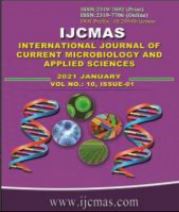


 National Academy of Agricultural Sciences (NAAS)
National Academy of Agricultural Sciences (NAAS)

|
PRINT ISSN : 2319-7692
Online ISSN : 2319-7706 Issues : 12 per year Publisher : Excellent Publishers Email : editorijcmas@gmail.com / submit@ijcmas.com Editor-in-chief: Dr.M.Prakash Index Copernicus ICV 2018: 95.39 NAAS RATING 2020: 5.38 |
Among the twenty five plant species belonging to different families viz., Chenopodiaceae, Leguminosae, Cucurbitaceae, Malvaceae, Amaranthaceae, Compositae and Solanaceae, only five species from Leguminosae family were systemically infected by virus causing mosaic disease of Soybean and the per cent transmission of the present virus varies from 70 - 100 per cent as per host species. Chenopodium amaranticolor and C. quinoa from Chenopodiaceae family which showed chlorotic local lesions (CLL) was the only two assay host. The remaining plant species in families viz., Leguminosae, Solanaceae, Cucurbitaceae, Malvaceae, Compositae and Amaranthaceae neither showed any symptom reaction nor the virus was recovered from them by back indexing on C. amaranticolor. The systemic symptoms produced by the virus upon mechanical inoculation on soybean were similar to those produced by plants infected naturally. In soybean the virus isolate exhibited vein clearing, mosaic mottling, puckering, distortion and curling of leaves and stunting of plants. Bean, cowpea and cluster bean showed mosaic mottling symptoms while dolichos bean showed necrotic local lesions. Thus, on the basis of symptomatology reaction the present virus was tentatively identified as soybean mosaic virus (SMV).
 |
 |
 |
 |
 |